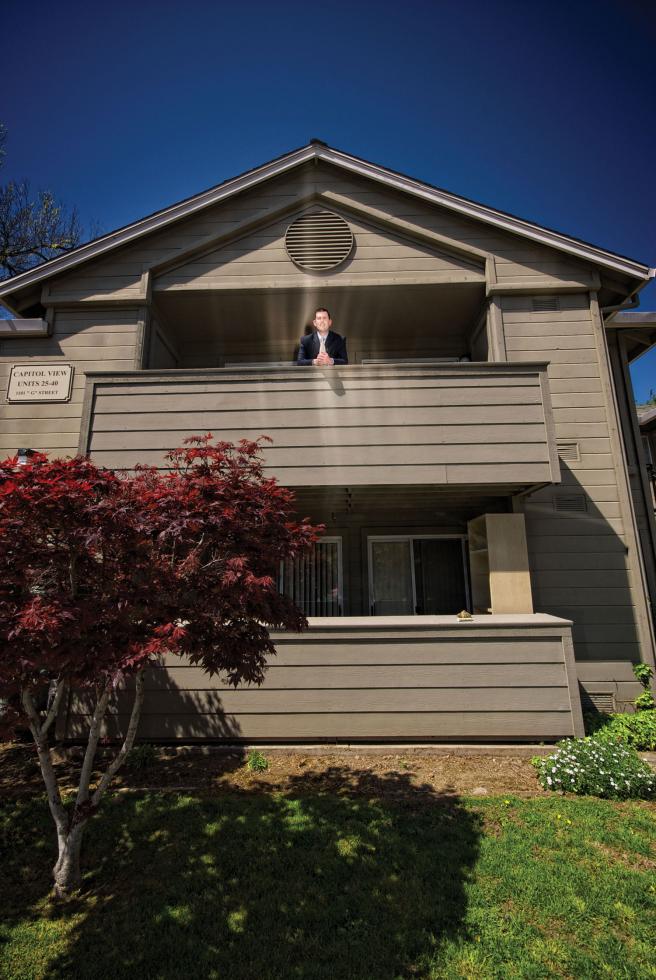Marc Ross, a senior associate with CB Richard Ellis in
Sacramento, specializes in investment and multifamily property.

The credit crunch and other broad changes in economic conditions cut a wide swath through the ranks of potential buyers. Those who are left are biding their time, lining up cash and waiting for a sweet deal, probably a distressed property at a bargain price. But far fewer multifamily properties are facing the default notices that helped drive down prices for single-family homes, and many landlords are trying to ride out the storm. The result is very few deals.
Ed Benoit became part of a rare breed early in 2009. He represented the sellers of eight rental units in Auburn in a deal that closed in January — one of just a handful of apartments or other multifamily properties that have sold since late 2008.
“I attribute it to good luck, clean living and a high grade point average,” says Benoit, a senior vice president and managing director with TRI Commercial in Roseville, tongue firmly in cheek.
The property, comprising four duplexes built in 1985 on a street just east of Highway 49, was listed in July for $1.5 million. “It had been on the market awhile, and we lowered the price,” Benoit adds. “We started about two years too late to sell it for a million-five.”
The discount to $985,000 drew a pair of offers; the deal closed for $1 million, one-third off the original asking price.
That’s the name of the game in the multifamily market in early 2009: There aren’t many deals, and the few buyers still in the market are looking for bargains. Capital is scarce, and a weak job market is depressing rents and boosting vacancy rates.
“Vacancies for professionally managed rental properties jumped by nearly a percentage point in the fourth quarter, and they’re climbing.”
Marc Ross, senior associate, CB Richard Ellis
“The fundamentals are softening,” says Marc Ross, a senior associate with CB Richard Ellis in Sacramento who specializes in investment and multifamily property. “Vacancies for professionally managed rental properties jumped by nearly a percentage point in the fourth quarter, and they’re climbing.”
Although winter typically sees softening of the apartment market, the vacancy rate in the Sacramento area hit 7 percent in the fourth quarter of 2008, up from 6.3 percent in the same period a year earlier. Colliers International data also showed higher vacancies locally in 2008.
Ross says January and February are also typically soft rental months, but property managers say early 2009 looked worse than usual.
One property manager, who spoke on condition he not be identified, says North Natomas has been hit hard by the changing market. The area is peppered with large complexes, which have seen higher vacancies and a need for big concessions on rent — the equivalent of more than two months free for a one-year lease in some cases — to prop up occupancy, the manager says.
The effects have been especially pronounced for one-bedroom units as unemployment rates climbed into double digits this year. In February, California’s unemployment rate hit 10.5 percent, according to the Employment Development Department.
Foreclosures might have given rentals a little boost last year by pushing families out of stand-alone homes and into apartments, Ross says. But trouble in the single-family home arena might now be creating more competition for apartments through a “shadow market” as owners who couldn’t sell homes in a falling market rent them out instead.
The shadow is definitely a factor in some communities, says Mike Force, president of Westcal Management, a Carmichael business that manages around 2,500 rental units across the Capital Region, mostly in complexes of 50 to 250 units. “In Woodland, we’ve lost tenants who were paying $800 a month for an apartment and were able to get into a duplex for $700 or $750.”
Combine that with the effects of increasing unemployment, and you get an uncomfortable pressure on rentals. “Job losses have started to really have an impact,” Ross says. “We’re seeing people doubling up (with roommates) or moving back home, and that takes renters out of the market.”
“In Woodland, we’ve lost tenants who were paying $800 a month for an apartment and were able to get into a duplex for $700 or $750.”
Mike Force, president, Westcal Management
John Gallagher, a managing director with TRI Commercial who specializes in multifamily property, estimated in early March that job losses had cut into rental occupancy rates in the region by about 2.5 percentage points. “I think landlords are starting to feel that pinch.”
Force says, “I’ve been here 18 years. We’ve had more people come in and drop their keys on the desk and say ‘I just can’t afford it’ than I’ve ever seen. … I would guess for the next six months it’s not going to improve.”
The problems are worst in high-end complexes such as recently built developments in North Natomas, Force says. “The Class A stuff is what’s hurting the worst.”
Other properties are holding up better. Rents are flat and may soften, says Robert Machado, president of HomePointe Property Management in Sacramento, which manages more than 2,200 units, most of them single-family homes for rent or small apartment buildings. “There’s a lot of supply coming in, but there are also people losing their homes. … If people aren’t buying homes, they’ve got to live somewhere.”
Machado said in early March that HomePointe was seeing pretty normal activity in the rental market, which “just chugs along” in the Capital Region. The key, he says, is careful tenant screening. “I think we maybe did a better job of vetting tenants” than lenders did at vetting buyers during the real estate boom.
Even without the troubling trends in rents and occupancy, it’s a good bet that few multifamily properties would be selling. There was a flurry of sales — including at least eight Class A apartment complexes — through the summer and fall of 2008, but things got chilly in a hurry late in the year. Colliers data showed 60 multifamily sales transactions in the Sacramento region in 2008, down from 98 in 2006 and 75 in 2007.
The credit crunch and other broad changes in economic conditions cut a wide swath through the ranks of potential buyers. Those who are left are biding their time, lining up cash and waiting for a sweet deal, probably a distressed property at a bargain price.
But far fewer multifamily properties are facing the default notices that helped drive down prices for single-family homes, and many landlords are trying to ride out the storm. The result is very few deals.
“The number of buyers has definitely decreased,” says Mark Leary, a principal with Apartment Realty Advisors, of San Francisco. Leary is representing BRE Properties as the giant real estate investment trust divests itself of Sacramento-area holdings. He put BRE’s 240-unit Arbor Pointe development in Sacramento and the 512-unit Overlook at Blue Ravine project in Folsom on the market in mid-February.
“We’ve got some people who are interested, … but the number of institutions is down,” Leary says. “Pension funds are out (of the market); REITs are net sellers across the country. That basically leaves private institutions and high-net worth individuals” as possible buyers for big apartment complexes.
“No one has a comfortable feeling for what market value is.”
John Gallagher, managing director, TRI Commercial
The buyers who are left, Leary says, are looking for a higher capitalization rate from their purchases, a measure of how much operating income a property generates as a percentage of its cost. A higher cap rate means an investment pays for itself faster. Those looking to buy now aren’t looking for appreciation of a property’s value; they’re looking “for a good return on their money from year one.”
And if they’re looking to buy, it’s a good bet they’re bringing a pile of cash with them. Not too long ago, banks were willing to lend millions to apartment buyers who put up 25 percent of the purchase price as a down payment. Now, assuming you can find a lender, the requirement is likely to be at least 35 percent in cash. The largest lenders in the Capital Region for multifamily deals in recent years were Citicorp and Washington Mutual. Now, brokers say, both are out of that market, and about the only source of debt financing available for a big purchase is a loan guaranteed by Fannie Mae or Freddie Mac.
At many banks, the largest multifamily loan available is $3 million to $5 million even with the more stringent requirements for leverage, says Ron Peters, who used to be a key player for Citicorp’s multifamily lending in Sacramento. Now he’s a senior vice president with Preferred Capital Advisors of Sacramento, a boutique mortgage-banking firm where he’s spearheading a new multifamily practice.
“There are some banks out there that will do the bigger deals, but it’s on a relationship basis,” for borrowers with a track record, Peters says. “The days of a Texas buyer coming in and doing a one-off deal are over, unless he can get his Texas bank to make the loan in California.”
With the depleted ranks of multifamily buyers and fewer sources of debt financing available, those buyers with deep pockets or strong banking relationships are in the best shape to make a deal. But the changes in the market are depressing property values, and there are so few deals that no one seems sure how much.
“No one has a comfortable feeling for what market value is,” says TRI’s Gallagher. “I’ve heard the phrase, ‘No one wants to catch a falling knife.’ … There are buyers that have funds. They are on the sidelines waiting for distressed sale opportunities.”
“The buyers are out there,” Peters concurs, “and they’re building up their balance sheets.”
A question remaining is how many distressed sale opportunities will arise. Gallagher says default notices are beginning to appear for properties with eight to 20 units, which could lead to foreclosures later this year, but larger properties haven’t been hit with many. Others say refinanced properties could hit trouble if the terms of the loans change or if they can’t find new financing. Falling rents or occupancy could add to the pressure.
Another question is just how sweet those deals will be. With so few deals closing, the market isn’t sending any messages about value, says Ross, of CB Richard Ellis. “Once there have been a few, that sort of establishes the new pricing equilibrium, but nobody knows what that new equilibrium is yet.”
Colliers International projects a drop, but not a huge one. In a January investment outlook for the Sacramento region, Colliers analysts said multifamily would fare better than other investment categories, but the availability of capital would still take a toll. “(O)ur projection is that multifamily will experience the fewest defaults, have the lowest levels of distressed properties impacting values and will retain the highest levels of demand from investors,” Colliers said. “As such, we see pricing decreasing by 10 percent to 20 percent at most for the weakest properties and stronger apartment communities largely holding their own.”
“Apartments are very much the preferred asset class among real estate investors.”
Nick Faklis, vice president, A.G. Spanos Cos.
The stakes are high because the cost of land and construction in the Capital Region makes it unlikely that new construction will be in the pipeline anytime soon. That could leave the owners of existing multifamily properties positioned to profit if the economy rebounds or rental demand rises.
“Apartments are very much the preferred asset class among real estate investors,” says Nick Faklis, vice president for dispositions with Stockton-based A.G. Spanos Cos., which builds multifamily complexes.
Spanos sold at least three complexes in Sacramento and Rancho Cordova in 2008. While new construction is planned in other U.S. markets such as Denver and Kansas City, there are no such plans for the Capital Region, Faklis says. “New development can’t happen simply because rents don’t cover the cost of new construction,” he says. “I don’t think anybody is going to be building anything for a while.”
In 2008, only 375 market-rate apartment units were completed in the Sacramento metro area, the lowest in a decade, according to CB Richard Ellis, and 2009 figures project no new market-rate units at all. Building permits were pulled for just 54 multifamily units in Stockton in 2008, the lowest number since 2000, according to the Construction Industry Research Board.
“Big picture: This is going to be a tough year,” Ross says. “We’re suggesting to landlords that they dig in and really pay attention and manage for occupancy” rather than trying to maximize rents.
“There are deals out there,” Peters says. “You have to position yourself through this recession for five to seven years out.”
Recommended For You

Hidden Treasures
Why Sacramento developers love historic remodels
Burke Fathy isn’t sure whether the building that housed Sacramento’s first Police Department will be converted to offices or apartments, but, as the managing partner of Sutter Capitol Group, he is sure the original architectural elements will stay.

Pushing Boundaries
Infill projects seek to redefine the way we envision Sacramento’s borders.
In California’s post-redevelopment era, landowners, developers and local governments have struggled to make infill projects pencil out. Unlike new suburban developments that offer blank canvases and creative freedom, infill projects are most often shoehorned into existing neighborhoods and commercial developments where community expectations are high and cleanup costs are steep.


